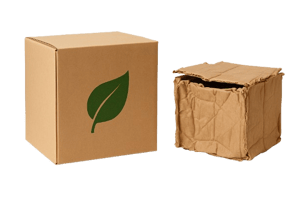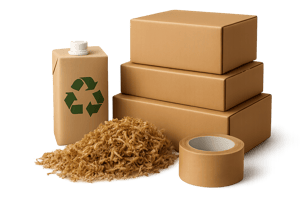Can mid-sized businesses afford to go green with packaging, and can they afford not to? It’s a question that a growing number of companies face. Big firms with deep pockets and dedicated teams often set the pace for sustainability. Small firms, on the other hand, can pivot quickly, trying new materials or packaging designs with relative ease. Mid-sized companies sit in the middle, facing budget constraints, operational pressures, and rising expectations from customers, suppliers, and regulators.
The Mid-Market Squeeze

As you might expect, mid-sized businesses are expected to match the environmental performance of larger competitors while maintaining the flexibility and efficiency that comes with being lean. Customers increasingly ask whether packaging is recyclable or reusable, suppliers want compliance assurances, and investors are taking note of ESG performance. Meanwhile, budgets are tight, and any operational change carries risk. The challenge is balancing ambition with practicality.
Cost Pressures

Sustainable packaging carries a reputation for being more expensive, and sometimes that’s true. Yet it’s quite rarely a simple trade-off. Vitally, investing in eco-friendly materials and designs can reduce costs over time. Fewer waste penalties, streamlined logistics, lighter shipping weights, and more efficient storage contribute to lifetime cost savings. Customers notice and reward businesses that show environmental responsibility, strengthening loyalty and repeat business.
For example, switching to recyclable mailers or mono-material cartons can cut disposal costs and make recycling easier for clients or end users. Over time, these investments often pay for themselves through operational efficiencies and enhanced brand perception.
Compliance Factors

Legislation adds another layer to the decision. UK rules, including plastic bans and Extended Producer Responsibility (EPR), are changing how companies must manage packaging. Even mid-sized businesses now have to think about what happens to packaging after it leaves the warehouse. Using materials that meet regulatory requirements isn’t just about avoiding fines. It’s about ensuring the business can operate smoothly while staying aligned with environmental standards.
Reputation Stakes

It’s a phrase that’s often said, but sustainability has become more than a nice-to-have in recent years. Customers, suppliers, and even investors are increasingly watching how companies manage environmental responsibility. Packaging that appears wasteful or hard to recycle can inevitably damage relationships and affect purchasing decisions. On the flip side, thoughtful, eco-friendly packaging signals that a business takes care of its operations, its supply chain, and the planet. That reputation can be a competitive edge in markets where differentiation is subtle but meaningful.
Practical Solutions for the Mid-Market

Finding the right approach doesn’t have to be complicated. Scalable, cost-effective solutions exist that mid-sized businesses can adopt without derailing day-to-day operations. No matter if it’s switching to recyclable films, using biodegradable void fill, or simply optimising carton sizes for transport efficiency, small adjustments add up. Careful selection of materials and packaging design can satisfy regulations, reduce waste, and enhance brand perception without breaking budgets.
Closing Thoughts
The right eco-packaging strategy balances three key things: cost, compliance, and credibility. Get it right, and sustainability becomes an asset, not a burden. Thoughtful decisions today can save money, protect the brand, and position a business for long-term success.
We’re here to help you explore practical packaging solutions that fit your business, strengthen supply chains, and support your sustainability goals. Contact us today to learn more. Send a message, email sales@allpack.uk.com, or call 01543 396 700.